
Bothrops alternatus is a highly venomous pit viper species found in South America. Within its range, it is an important cause of snakebite. The specific name, alternatus, which is Latin for "alternating", is apparently a reference to the staggered markings along the body. No subspecies are currently recognized.

Bothriechis is a genus of pit vipers, commonly called palm vipers or palm-pitvipers found predominantly in Mexico and Central America, although the most common species, B. schlegelii, ranges as far south as Colombia and Peru. All members are relatively slender and arboreal. The name Bothriechis is derived from the Greek words bothros and echis that mean "pit" and "viper" respectively. Ten species and no subspecies are currently generally recognized.

Cerrophidion is a genus of pit vipers which are endemic to southern Mexico, Central America, and western Panama. The generic name, Cerrophidion, is derived from the Spanish word cerro, which means "mountain", and the Greek word ophidion, which means "small snake". Five species are recognized as being valid, but no subspecies are.

Bothrops ammodytoides is a pit viper species endemic to Argentina. No subspecies are currently recognized.
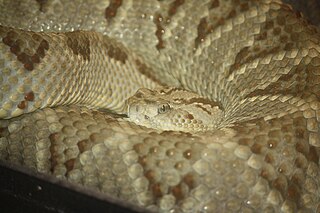
Crotalus simus is a venomous pit viper species found in Mexico and Central America. The specific epithet is Latin for "flat-nosed", likely because its head is blunt compared with lanceheads (Bothrops). Three subspecies are recognized, including the nominate subspecies described here.

Bothriechis nigroviridis is a pit viper species found in the mountains of Costa Rica and Panama. No subspecies are currently recognized. The specific name is derived from the Latin niger (black) and viridis (green) in reference to its distinctive color pattern.
Atropoides picadoi, also known as Picado's jumping pit viper, is a pit viper species in the subfamily Crotalinae of the family Viperidae. The species is endemic to Costa Rica. There are no subspecies that are recognised as being valid. It is monotypic in the genus Atropoides.

Porthidium dunni is a species of pit viper in the family Viperidae. The species is endemic to Mexico. There are no recognized subspecies.

Porthidium hespere is a pit viper species found in western Mexico. No subspecies are currently recognized.
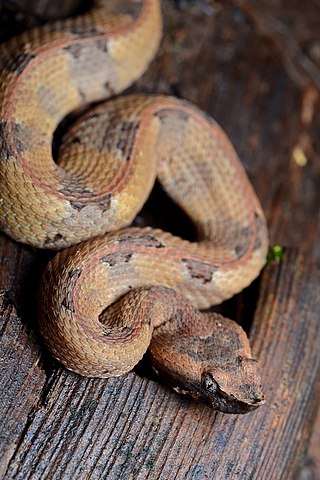
Porthidium nasutum is a pit viper species found in southern Mexico, Central America and northern South America. No subspecies are currently recognized.
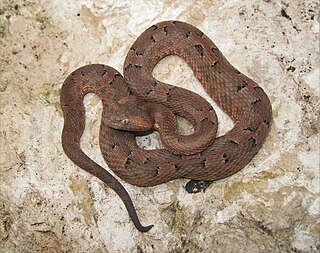
Porthidium yucatanicum is a pit viper species found in Mexico. No subspecies are currently recognized.

Porthidium lansbergii is a species of venomous snake, a pit viper in the family Viperidae. The species is endemic to Central and South America. Four subspecies are recognized, including the nominate subspecies described here.
Agkistrodon howardgloydi is a species of venomous snake, a pit viper in the subfamily Crotalinae of the family Viperidae. The species is endemic to Central America. It is most commonly called castellana, but it has also been called the southern cantil, Gloyd's moccasin, and a number of other colloquial names. It is a rare species with a relatively small geographic distribution in the tropical dry forest on the Pacific coast of Honduras, Nicaragua, and extreme northwest Costa Rica. A. howardgloydi is a stout, medium-sized snake with a maximum total length of 96 cm (38 in). It is a viviparous species, with females giving birth in the rainy season from May to August. No clinical reports on envenomation had been published, but laboratory texts and analysis indicate the venom is highly toxic and similar to its close relative Agkistrodon bilineatus, and potentially lethal.

Metlapilcoatlus mexicanus is a pit viper species endemic to Mexico and Central America.
Metlapilcoatlus occiduus is a pit viper subspecies endemic to southern Mexico, Guatemala, and El Salvador.

Lachesis stenophrys, commonly called the Central American bushmaster, is a species of venomous pit viper in the family Viperidae. The species is native to Central America.

Lachesis melanocephala is a species of venomous pit viper in the family Viperidae. The species is native to Costa Rica and Panama. There are no subspecies that are recognized as being valid.
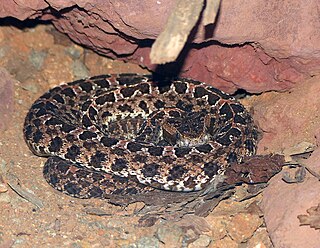
Porthidium ophryomegas is a venomous pitviper species found in Central America. No subspecies are currently recognized.
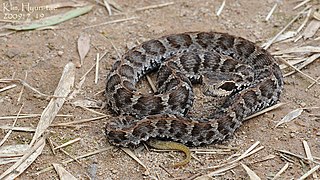
Gloydius brevicauda is a pit viper species endemic to China and the Korean Peninsula.

Bothrocophias campbelli, commonly known as Campbell's toadheaded viper, the Ecuadorian toadheaded pitviper, and víbora boca de sapo in Spanish, is a species of venomous pitviper in the family Viperidae. The species is endemic to South America. No subspecies are currently recognized.
















